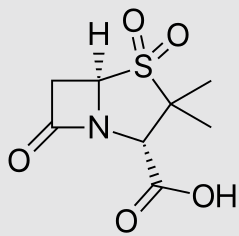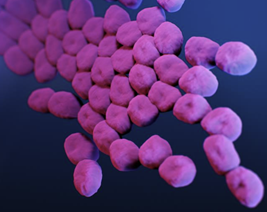Medical Pharmacology Chapter 35 Antibacterial Drugs
Penicillins And Others
Beta-lactamase inhibitors
 |
Mechanism of Action
Sulbactam is a semisynthetic beta-lactamase inhibitor derived from penicillanic acid sulfone.
![]() Like
clavulanate, it
irreversibly acylates serine beta-lactamases and
permanently inactivates them.1
Like
clavulanate, it
irreversibly acylates serine beta-lactamases and
permanently inactivates them.1
Sulbactam’s structure is similar to a penicillin, and it covalently binds to the enzyme’s active site.
In addition to its enzyme-inhibiting action, sulbactam itself has weak intrinsic antibacterial activity against certain bacteria.
Sulbactam can bind to penicillin-binding proteins of Acinetobacter baumannii and Neisseria species, conferring some direct bactericidal effect.1
 |
|
This intrinsic activity is limited but clinically relevant against A. baumannii.
high-dose sulbactam can be used as a treatment option for multi-drug-resistant Acinetobacter infections where sulbactam’s own antibacterial effect is leveraged.1
Pharmacokinetics
Sulbactam is usually given parenterally (IV/IM), most often as ampicillin-sulbactam (brand name Unasyn).
Sulbactam exhibits poor oral absorption unless given as the double-ester prodrug sultamicillin.
After IV administration, sulbactam distributes in extracellular fluid compartments; it achieves therapeutic levels in tissues like lung, pleural fluid, bile, and peritoneal fluid. Its half-life is roughly 1 hour in patients with normal renal function.2
Sulbactam is ~38% protein-bound in plasma.2
Sulbactam undergoes minimal metabolism; <25% of the dose may be metabolized hepatically.3 Renal excretion is the dominant elimination route, with about 70–85% of a dose excreted unchanged in the urine.2,3
Because of this, dose adjustments are required in renal impairment to avoid accumulation.
Sulbactam’s pharmacokinetics are not significantly altered by coadministration with ampicillin – the two drugs have parallel kinetics and are often given in a fixed 2:1 ampicillin:sulbactam ratio.2
Therapeutic Uses
![]() Sulbactam
is combined with the aminopenicillin ampicillin in a 2:1 ratio.
Sulbactam
is combined with the aminopenicillin ampicillin in a 2:1 ratio.
Ampicillin-sulbactam exhibits of productivity, covering many ß-lactamase-producing bacteria responsible for community-acquired in some hospital-acquired infections.
Ampicillin-sulbactam is typically considered an empiric therapy for moderate community-acquired infections requiring hospitalization, such as intra-abdominal or pelvic infections, and remains a reliable agent in both adult and pediatric infections.1
Oral sultamicillin is available in some regions for step-down therapy or outpatient treatment of milder infections, providing an oral route for sulbactam use.1
Intra-abdominal and gynecologic infections
Diverticulitis, peritonitis, cholecystitis, endometritis are examples of infection where Enterobacteriaceae and anaerobes (Bacteroides, etc.) are common.
Ampicillin-sulbactam provides broad coverage of these, except Pseudomonas.1
Respiratory tract infections
These infections include aspiration pneumonia and ventilator-associated pneumonia (if due to susceptible organisms).
Ampicillin-sulbactam is effective for aspiration pneumonia as it covers oral anaerobes along with typical respiratory pathogens.1
Ampicillin-sulbactam is also used in acute epiglottitis and periorbital/orbital cellulitis, where H. influenzae and mixed flora are concerns.1
Skin and soft tissue infections
Examples of skin/soft tissue infections include diabetic foot infections or deep soft tissue abscesses, especially polymicrobial ones, given ampicillin-sulbactam activity against staphylococci, streptococci, and anaerobes.1
Obstetric infections
Ampicillin-sulbactam is indicated for postpartum endometritis, pelvic inflammatory disease, or septic abortion, covering Enterobacteriaceae and anaerobes.
Community-acquired pneumonia
Ampicillin-sulbactam IV can be used for hospitalized patients with pneumonia due to beta-lactamase producing H. influenzae or Moraxella, as well as for aspiration pneumonia as noted.
Acinetobacter infections
Sulbactam is uniquely useful against carbapenem-resistant A. baumannii, as A. baumannii often has intrinsic susceptibility to sulbactam’s antibiotic action on PBP-2.
High-dose sulbactam (often administered as ampicillin-sulbactam or with a new enhancer durlobactam) is used off-label for difficult Acinetobacter infections when other options are limited.1
Adverse Reactions
The addition of sulbactam does not greatly change the adverse effect profile of ampicillin; overall it is well tolerated.
The most common side effect is diarrhea (and related GI upset), as is typical for broad-spectrum penicillins.1,2
Ampicillin by itself frequently causes diarrhea due to incomplete absorption and high biliary excretion; sulbactam may add to this by altering gut flora.
Other adverse effects include nausea, rash, and injection site pain (if given IV or IM).
Hypersensitivity reactions can occur (any patient allergic to penicillin should not receive ampicillin-sulbactam, as cross-reactivity is expected).2
August, 2025
|
|
This Web-based pharmacology and disease-based integrated teaching site is based on reference materials, that are believed reliable and consistent with standards accepted at the time of development. Possibility of human error and on-going research and development in medical sciences do not allow assurance that the information contained herein is in every respect accurate or complete. Users should confirm the information contained herein with other sources. This site should only be considered as a teaching aid for undergraduate and graduate biomedical education and is intended only as a teaching site. Information contained here should not be used for patient management and should not be used as a substitute for consultation with practicing medical professionals. Users of this website should check the product information sheet included in the package of any drug they plan to administer to be certain that the information contained in this site is accurate and that changes have not been made in the recommended dose or in the contraindications for administration. Advertisements that appear on this site are not reviewed for content accuracy and it is the responsibility of users of this website to make individual assessments concerning this information. Medical or other information thus obtained should not be used as a substitute for consultation with practicing medical or scientific or other professionals. |